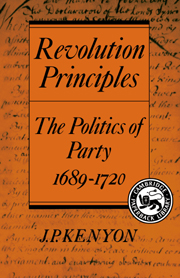Book contents
- Frontmatter
- Contents
- Preface
- Preface to the paperback edition (1990)
- 1 Introduction
- 2 By force or by miracle
- 3 The measure of submission
- 4 This skein of tangled principles
- 5 King Charles's head
- 6 The bloody flag
- 7 Revolution Principles
- 8 Black and odious colours
- 9 The four last years
- 10 That triumphant appellation
- 11 Conclusion
- Appendix
- Abbreviations
- Notes
- Addendum
- Index
4 - This skein of tangled principles
Whig political thought in the 1690s
Published online by Cambridge University Press: 07 October 2009
- Frontmatter
- Contents
- Preface
- Preface to the paperback edition (1990)
- 1 Introduction
- 2 By force or by miracle
- 3 The measure of submission
- 4 This skein of tangled principles
- 5 King Charles's head
- 6 The bloody flag
- 7 Revolution Principles
- 8 Black and odious colours
- 9 The four last years
- 10 That triumphant appellation
- 11 Conclusion
- Appendix
- Abbreviations
- Notes
- Addendum
- Index
Summary
The Whig view of the Revolution was based firmly on English history. In The Fundamental Constitution of the English Government (1690) William Atwood acknowledged that Locke had established government ‘upon the only true foundation, the choice of the people, that original and supreme act of society, antecedent to all positive laws in it’. He also agreed that ‘upon King James's abdication…the people were restored to that liberty which they had before the settlement of the crown, which was in force till the Original Contract was broken by him’. But, as we have seen, he flinched from Locke's proposition that society then dissolved into ‘a confused multitude’, arguing instead that the continuity of the community was represented by parliament, even if, as in 1689, it had not been properly summoned, and the central part of the work (chapters 3–8) is devoted to a detailed review of English history, showing that kingly rule had always been by agreement and consent, that monarchy had always been elective, and that plenty of kings had been deposed or restrained for breaking the contract. He appeared to date the first historical appearance of the contract in Edward the Confessor's reign, but he went back as far as Egbert of the West Saxons to demonstrate the people's exercise of their rights. Daniel Whitby, in An Historical Account of Some Things relating to the Nature of the English Government and the Conceptions Which Our Forefathers Had of It, also published in 1690.
- Type
- Chapter
- Information
- Revolution PrinciplesThe Politics of Party 1689–1720, pp. 35 - 60Publisher: Cambridge University PressPrint publication year: 1977
- 1
- Cited by

